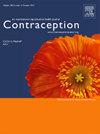Development of a transdermal gel for reversible male contraception
IF 2.8
2区 医学
Q1 OBSTETRICS & GYNECOLOGY
引用次数: 0
Abstract
While there are several easy-to-use reversible female contraceptives, little is available for men. Introduction of novel, cost-effective male contraceptives could have important downstream global health and economic benefits. Currently, nearly half of all pregnancies globally are unintended, with many resulting in unsafe abortions, a significant burden for women and families in many countries.
Available reversible options for male contraception include male condoms or withdrawal, both with high typical use failure rates, and vasectomy, which is not easily reversible. Advanced methods of male hormonal contraception include combinations of progestin and androgen, generally testosterone itself. Administration of these steroids results in the suppression of gonadotropins leading to the suppression of sperm production with full reversibility within a few months. Importantly, the exogenous androgen replaces the suppressed endogenous testosterone, minimizing side effects for the user. Using the skin to deliver steroids in the systemic circulation is a well-accepted concept both for the treatment of hypogonadism and contraception. A transdermal gel delivering Nestorone (segesterone acetate) and testosterone is under development and is leading the way in advancing novel, self-delivered methods of male hormonal contraception.
可逆性男性避孕透皮凝胶的研制。
虽然有几种易于使用的可逆女性避孕药,但可供男性使用的却很少。采用新型、成本效益高的男性避孕药具可能对全球健康和经济产生重要的下游效益。目前,全球近一半的怀孕是意外怀孕,其中许多导致不安全堕胎,这对许多国家的妇女和家庭来说是一个重大负担。可用的可逆男性避孕选择包括男性避孕套或退出,这两种方法的典型使用失败率都很高,输精管结扎术不容易逆转。先进的男性激素避孕方法包括黄体酮和雄激素的结合,通常是睾酮本身。服用这些类固醇会抑制促性腺激素,从而在几个月内完全可逆地抑制精子的产生。重要的是,外源性雄激素取代了抑制的内源性睾酮,最大限度地减少了使用者的副作用。利用皮肤在体循环中输送类固醇是治疗性腺功能减退和避孕的一个广为接受的概念。一种提供Nestorone®(醋酸孕酮)和睾酮的透皮凝胶正在开发中,并在推进男性激素避孕的新颖、自我释放方法方面处于领先地位。
本文章由计算机程序翻译,如有差异,请以英文原文为准。
求助全文
约1分钟内获得全文
求助全文
来源期刊

Contraception
医学-妇产科学
CiteScore
4.70
自引率
17.20%
发文量
211
审稿时长
69 days
期刊介绍:
Contraception has an open access mirror journal Contraception: X, sharing the same aims and scope, editorial team, submission system and rigorous peer review.
The journal Contraception wishes to advance reproductive health through the rapid publication of the best and most interesting new scholarship regarding contraception and related fields such as abortion. The journal welcomes manuscripts from investigators working in the laboratory, clinical and social sciences, as well as public health and health professions education.
 求助内容:
求助内容: 应助结果提醒方式:
应助结果提醒方式:


